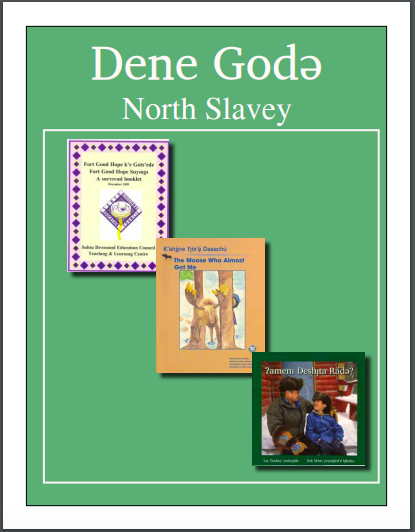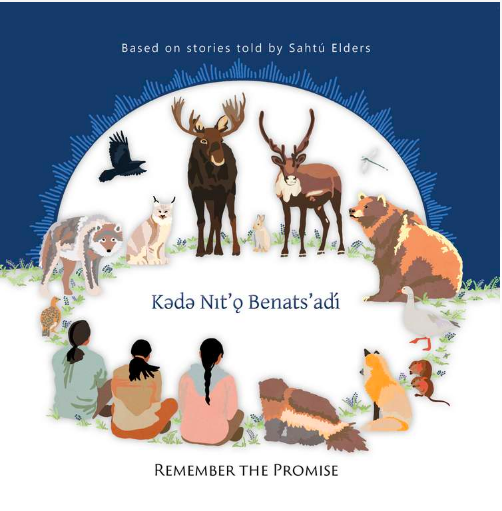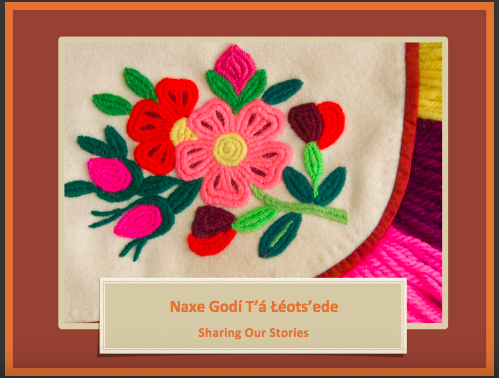Dene Kedǝ to Dene Ts'ı̨lı̨ (1st ed) Appendix E: Timeline of Dene Kedǝ and Dene Ts’ı̨lı̨ Events
This document is one of six appendices from the first iteration of the report From Dene Kedǝ to Dene Ts’ı̨lı̨: Rethinking Resurgence in the Sahtú Region. In it, the team provides a timeline of selected events and projects throughout Sahtú history, contextualized by events in the Northwest Territories and in Canada.
About the project:
From Dene Kedǝ to Dene Ts’ı̨lı̨ is a collaborative project that explores lessons learned through the past fifty years of Dene and Métis language and way of life initiatives. Bringing together knowledge and experience from longtime activists and educators and youth, as well as review of over 275 documents, the aim is to create a resource for decision-makers and researchers as a basis for resurgence in the Sahtú Region. All phases of this project involve a dialogue between today’s initiatives and yesterday’s legacy.
The picture that has emerged is complex, involving at least seven domains of resurgence: speakers and learners; local knowledge; documentation; education; media; law and policy; and ways of life. During this project we saw the emergence of exciting projects like the Dene Ts’ı̨lı̨ School, a cross-cultural on the land learning opportunity for youth. This school became an integral part of the research and learning process.
Read more about From Dene Kedǝ to Dene Ts’ı̨lı̨. Download the appendix using the PDF link at the bottom of this page.
Cite this resource:
"Appendix E - Timeline of Dene Kedǝ and Dene Ts’ı̨lı̨ Events" in Faun Rice, Keren Rice, Deborah Simmons, Walter Bezha, Jordan Lennie, Shelby Lennie, Michael Neyelle. From Dene Kedǝ to Dene Ts’ı̨ lı̨: Rethinking Resurgence in the Sahtú Region, Northwest Territories©Ɂehdzo Got’ı̨ nę Gots’é ̨ Nákedı (Sahtú Renewable Resources Board), Tulı́ t'a, Northwest Territories, www.srrb.nt.ca. October 2017 Edition.
Dene Godǝ - North Slavey Bibliography
This 20 page bibliography provides publication information, summaries, keywords, and images of book covers for Dene Kedǝ language and literacy resources. It appears to be organized very loosely by date of publication, ranging between 1979 and 2007. Original sources for a number of publications in the 1980s were the Black Lake First Nations, adapted for the Sahtu. A trend of the time to save on cost and effort was to use templates from other areas to develop materials.
Read more about Dene language learning resources by selecting the tags "language" or "education" on the left hand menu.

Access this Resource:
This resource is attached as a PDF below, and is also available on the SSDEC website.
Sahtú Divisional Education Council. Dene Godǝ - North Slavey Bibliography. Norman Wells: Sahtu Divisional Education Council, n.d.
Kǝdǝ Nıt’ǫ Benats’ adı́ - Xǝdǝ Rı́hęt’ǫ Herats’ǝ́dı (Remember the Promise)
From Introduction: "In March 2013, elders, Dene language specialists and others got together for a workshop to talk about how the story of species at risk can be understood through the language and stories of Dene and Métis. They agreed that the main people who need to work on these things are the present and future youth of the Sahtú Region. This book is dedicated to the workshop participants, and to the youth who are the future stewards of the land.
The first part of this book is a story, Remember the Promise, with Dene words. The meanings of those words can be found in the glossary (page 18). The second part includes more details about the workshop and the terms that were worked on in the dialects of Délı̨nę, Tulı́t’a, and K’asho Got’ı̨nę. The last part has more information about species at risk in the NWT.
Keeping the Dene language alive is part of keeping alive people’s sacred and respectful relationships with other living things. We hope that this book will encourage people to speak and understand the language of this land, the language of the ancestors. Through the language, we are sure to remember the promise."
Read more about this project, and access the full text in multiple languages, on the Remember the Promise page on the SRRB site.
Sahtú Renewable Resources Board. Kǝdǝ Nıt’ǫ Benats’adı́, Remember the Promise. Compiled by Betty Harnum and Deborah Simmons, with a foreword by Michael Neyelle, 2014.
Naxe Godı́ T’á Łéots’ede, Sharing our Stories
This document is a public collections record featuring stories and photographs of objects from the Sahtú region. It was developed between 2013 and January 2014 by the Prince of Wales Northern Heritage Centre (PWNHC) and:
Elders: Maurice Mendo, Camilla Tutcho, and Vicki Orlias
Interpreter: Lucy Ann Yakelaya
Students: Dalton Takazo, Darren Horassi, Carmen McNeely, and Chantelle Orlias
Chaperones: Jessie Campbell and Richard Andrew
Sponsors: The PWNHC and Education, Culture, and Employment (GNWT)
Workshop Coordinator: Wendy Stephenson
Naxe Godı́ T’á Łéots’ede, Sharing our Stories documents a workshop wherein Elders, Students, and other Sahtú region participants gathered to give oral histories to objects in the Prince of Wales Northern Heritage Centre (PWNHC) collection. Objects such as mukluks were identified in as many different Sahtú dialects as possible, Délı̨nę, Tulı́t’a, and Fort Good Hope. Students listened to elders talk about their purpose and history, and Elder’s quotations were preserved by the PWNHC in this record.
Access this Resource:
The PWNHC has the full text of this book and other language communities' projects on their website: https://www.pwnhc.ca/collections/sharing-our-stories/
Prince of Wales Northern Heritage Centre and Sahtú Dene Elders. Naxe Godı́ T’á Łéots’ede, Sharing our Stories. Yellowknife, 2014.
Resources for Teaching Aboriginal Languages in the Northwest Territories: An Annotated Bibliography
This document is an immensely useful resource for teachers and students of Indigenous languages in the Northwest Territories. It provides a collection of language books published in: Cree, North Slavey, South Slavey, Chipewyan, Tłįchǫ̨, and Gwich’in. Teaching and Learning Centres, other Community Language Groups, and numerous school boards and Divisional Education Councils contributed to its creation, with sponsorship from the GNWT and the Government of Canada through the Department of Canadian Heritage.
The Dene Godǝ, North Slavey portion of the annotated bibliography contains numerous resources that are not already referenced in this Dene Kedǝ to Dene Ts’ı̨lı̨ database.
Access this Resource:
The Yamózha Kų́ę́ Society has made this resource available open access here.
Visit the SSDEC's full list of resources, including other annotaded bibliographies: https://www.ssdec.net/aboriginal-language
Kaulback, Brent. Resources for Teaching Aboriginal Languages in the Northwest Territories: An Annotated Bibliography. Hay River and Fort Smith: Yamózha Kų́ę́ Society/South Slave Divisional Education Council, 2010.
Northern Dene Bibliography (incomplete)
This 66 page list of social, cultural and linguistic sources is presented as a work in progress, and the author encourages people to contact him at This email address is being protected from spambots. You need JavaScript enabled to view it. to contribute to the list or be provided with updates (this was not done at time of writing). The list is organized by geographical areas, as well as topics. The geographical scope for each section is very broad, being divided into only two groups. The first section focuses on “Dene ("Chipewyan" - Northern SK and MB, NWT).” Resources related to the Sahtú are encompassed within a section entitled “Dene (B.C., AB, Yukon, NWT) … some Algonquian Sources.” Sections include: Social and Cultural (pages 18-39); Language (pages 40-42); Hearne Bibliography (pages 42-44); Resource Books (pages 44-47); University Dissertations (pages 47-66; this is the only section that includes abstracts).
Access this Resource:
http://northernwaterways.com/MYCCR/northern_dene_biblio.pdf
Labenski, Ed. Northern Dene Bibliography (incomplete). Chicago, University of Chicago. 1998.
Final Report: Dene Language/Historical Research Project
This report covers the period of January 1st to March 31st, 1983. It documents accessions, including cassette recordings (many of interviews with Dene and English summaries), photographs, printed materials, and artifacts. The research team also recorded numerous place names in locations such as Fort Smith and Colville Lake. Keren Rice and Lucy Ann Yakaleya ran a workshop in Dene language and translations from February 7 to 18 for the research project team. The group was, at the time of writing, preparing to transition to curriculum development and gathering information about appropriate language teaching pedagogy. They also developed partnerships with the Prince of Wales Northern Heritage Center and other organizations to pursue professional development and contribute to language and placename documentation.
Access this Resource:
This document is accessible from the NWT Archives.
NWT archives accession no. 2007-14 (Cynthia Chambers Collection).
Dene Community Council. Final Report: Dene Language/Historical Research Project. Fort Good Hope: NWT Department of Education, 1983.
Letter to Cynthia Chambers
This letter contains a list of catalogue cards of manuscripts and tapes “in the Hiroko Sue Hara collection” held by National Museums of Canada at this time. It lists numerous audio recordings (such as “Hare Indian Love song and drum, by Antoine Abelon”) and also notes that it has Keren Rice’s field notes on Hare phonology, with a related tape.
Access this Resource:
Dallaire, Louise. Letter to Cynthia Chambers, 16 June 1982. NWT Archives, Northwest Territories. Cynthia Chambers – Dene Language and Culture Collection, N-2007-014.




 Phone: 867-374-4040
Phone: 867-374-4040 Email:
Email: